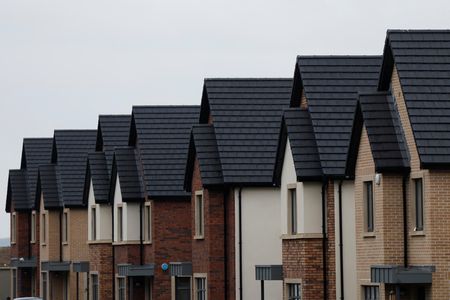DUBLIN (Reuters) -Ireland’s two dominant banks are not receiving enough demand from housebuilders to use all the funds they have earmarked for housing projects, executives said on Tuesday, highlighting the challenges Ireland faces in ramping up much needed supply.
Ireland has struggled to house a rapidly growing population since a slump in the construction industry in the wake of a 2009 property crash, with the lack of supply pushing house prices up 162% from a 2013 trough and roughly doubling rents.
Bank of Ireland, the primary lender to the sector alongside main rival AIB, last year increased its pool of funding for housing developments by 40% to 2.5 billion euros ($2.81 billion), saying it wanted to play a bigger role in the government’s plan to see an average 50,000 new homes built annually over six years.
Bank of Ireland’s head of corporate and commercial banking said the lender is struggling to find enough projects beyond the 1.2 billion euros already committed that will be drawn from the 2.5 billion euro funding pool.
“We’re not seeing the number of projects coming at us that we would love to be seeing to get to a point where banking capacity is a challenge,” John Feeney told a banking conference.
AIB managing director for capital markets, Cathy Bryce, told the same conference that her bank would also like to be lending “a lot more” into the sector than it currently is.
Bryce highlighted the limitations of a highly fragmented construction sector and issues around the predictability of returns for equity investors linked to planning delays, land availability, affordability and rental regulations.
The government is considering amending regulations that cap rent increases at a maximum of 2% a year after a collapse in privately funded apartment building pushed the number of homes built last year down 7% to a little more than 30,000.
Ireland’s central bank expects the government to fall short of its target over the next three years to boost housing supply by 50,000 a year. House completions rose 2% year on year in the first quarter but were down 10% on the same period in 2023.
“We haven’t seen any sort of spike up in the level of applications or activities, so that’s a harbinger that we’re not yet on track to get up to the much larger numbers that have been mooted,” Bank of Ireland’s Feeney said.
($1 = 0.8903 euros)
(Reporting by Padraic Halpin; Editing by Susan Fenton)









